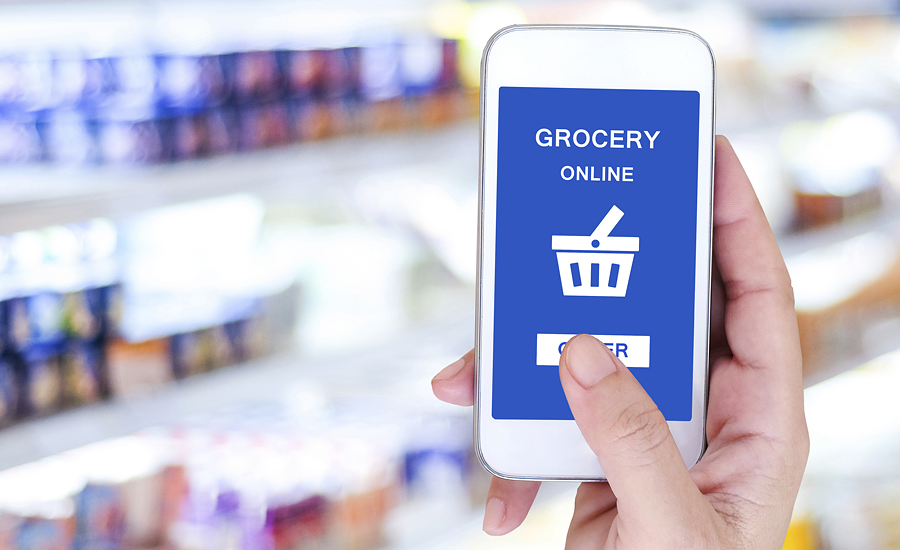Online grocery in the United States is on the cusp of a major increase in consumer adoption. That’s because e-commerce penetration is expected to at least triple in the next decade, according to new research from Bain & Co., Boston, Mass., and Google, Mountain View, Calif.
The study, “Omnichannel Grocery is Open for Business – and Ready to Grow,” which surveyed more than 8,000 grocery shoppers across the United States, reveals that penetration hovers at a mere 3%. According to the research, that’s because while just 25% of consumers surveyed said they used an online grocery service in the last year, only 26% of those users, or 6% of all consumers, say they have been placing online orders more than once a month.
“Online grocery shopping in the U.S. trails that of other e-commerce categories in large part because our grocery shopping habits are so deeply ingrained, and online grocery retailers haven’t yet convinced customers that grocery shopping online can be a better experience,” says Stephen Caine, a leader in Bain & Co.’s retail practice. “Traditional grocers have decades of experience optimizing their physical stores to align with how shoppers think – training them to navigate store shelves to easily find what they are looking for, making it easy for them to make trade-offs between products and providing inspiration when they want to try something new. Online grocery shopping has not yet found a way to digitally replicate these cues simply and intuitively.”
Consumers also remain dependent on familiar “analog” tools, such as written lists, to aid planning and shopping.
The findings suggest that changing these and other shopping patterns is not an insurmountable challenge for omni-channel grocery retailers, and can seize this opportunity by addressing three imperatives:
Bridge the convenience gap
Convenience, in the context of buying groceries online, boils down to an experience that saves time while also creating an intuitive and frictionless shopping experience from start to finish.
By this definition, today’s grocery retailers are not yet consistently delivering a more convenient experience online. Among online grocery shoppers who say they have shopped online for groceries just once in the past 12 months, only 42% report that the online experience saved them time.
Consumers need to experiment with an online grocery service multiple times to recognize the value of shopping online and understand how it can become an essential part of their routine. Retailers must then invest, not just in acquiring the shopper once, but three or more times to convince the benefits of shopping online. Bain & Co. found that 63% of online grocery shoppers who have shopped for groceries online three times say that online grocery shopping saved them time compared to an in-store trip. That’s a jump of 20 percentage points above those first-time online shoppers.
Capitalize on the incumbent advantage
When it comes to building share online, traditional grocers have an unexpectedly powerful advantage, the research found. Consumers who had not used an online grocery service in the past year were asked which one they would select if they had to give it a try. Almost all (96%) said they would look first to a traditional brick-and-mortar retailer for home delivery, and 85% said they would select a store they already visit.
This home-store bias makes sense, since grocery shoppers have already made well-informed decisions about which retailers they trust. Only 17% of consumers surveyed say they have tried a new retailer in their area within the last three months, and only 25% said they are likely to try a new retailer for a routine grocery trip.
“Winning a first trial is so important because there is a general consumer ‘stickiness’ when it comes to online grocery—75% of online grocery shoppers say they are still using the first online grocer they tried,” says Michelle Paratore, a member of Bain & Co.’s retail practice. “Knowing that existing consumers are likely to try their online offering first, omni-channel retailers are well-positioned to keep these shoppers for continued visits and purchases as long as they deliver an experience that is convenient and meets shoppers’ needs.”
Invest to make digital an edge
Traditional grocers have the opportunity to embrace digital tools to increase convenience for in-store shoppers, helping to strengthen customer retention. For example, the survey found that grocery shoppers who have not shopped online in the past 12 months say that building a shopping list and having ways to compare prices are the two features they would value most from an online grocery retailer. This contrasts with more advanced features, such as personalized recommendations and substitution algorithms that retailers could pour significant funds into, but matter less to consumers. Voice assistants and grocery apps are two categories of tools well positioned to deliver on these urgent shopper needs.
Only 4% of grocery shoppers say they have adopted voice assistants on dedicated devices for grocery planning, much lower than the estimated 23-32% of U.S. adults who own smart speakers. But, adopters are using them frequently – 66% of grocery shoppers who use voice assistants say they use the tool weekly or more frequently for grocery planning.
“Although the shift online will rapidly accelerate, we anticipate that the majority of grocery spend is still expected to occur in physical stores in 2030,” says Caine. “The winners in this changing grocery landscape will be the retailers that can deliver frictionless omni-channel experiences, investing in digital experiences and tools that save time for consumers shopping online or in the store.”


